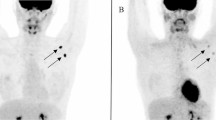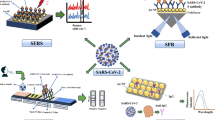Abstract
Background
Diarrhea is a major cause of severe gastrointestinal illness in the infant especially in many developing countries. Although this molecular technique has been accepted as standard technique to detect Diarrhea-causing EPEC, the practical aspect of this technique for in-site rapid screening purposes is still facing a major challenge. In this study, we characterized EPEC specific aptamers and applied it as an AuNP-based aptasensor for point of care (POC) diagnosis purpose.
Methods
As many as six selected DNA aptamers was screened using target bacteria and the bound aptamer was measured by qPCR technique. Moreover, Kd value for each optimal bound aptamer was measured by using the same technique. Colorimetry assay was applied to test specificity and LOD of AuNP-based aptasensor.
Results
Two DNA aptamers have been successfully obtained to detect Enteropathogenic Escherichia coli K.1.1. DNA aptamer S8-7 exhibited constant dissociation (Kd) value of 17.08 nM, while DNA aptamer S10-5 exhibited Kd value of 34.14 nM. AuNP-based aptasensor showed high selectivity and specificity for EPEC K.1.1 with a limit of detection (LOD) value of 105 CFU/mL. Truncation study on DNA aptamer S8-7 showed that elimination of primer binding sequence only slightly increased both performance of detection and LOD value of AuNP-based aptasensor.
Conclusion
Further study is necessary to improve AuNP-aptasensor performance such as through mutagenesis approach on targeted DNA aptamers before AuNP-based aptasensor can be applied as a biosensor in point of care (POC) diagnosis.





Similar content being viewed by others
References
Kaper JB, Nataro JP, Mobley HLT (2004) Pathogenic Escherichia coli. Nat Rev Microbiol 2:123–140
Dias RCB, dos Santos BC, dos Santos LF, Vieira MA, Yamatogi RS, Mondelli AL, Sadatsune T, Sforcin JM, Gomes TAT, Hernandes RT (2016) Diarrheagenic Escherichia coli pathotypes investigation revealed atypical enteropathogenic E. coli as putative emerging diarrheal agents in children living in Botucatu, São Paulo State, Brazil. APMIS 124:299–308
Donnenberg MS, Whittam TS (2001) Pathogenesis and evolution of virulence in enteropathogenic and enterohemorrhagic Escherichia coli. J Clin Invest 107:539–548
Firdausi Qadri AM, Svennerholm ASGF, Sack RB (2005) Enterotoxigenic Escherichia coli in developing countries: epidemiology, microbiology, clinical features, treatment, and prevention. Clin Microbiol Rev 18:465–483
Walker CLF, Sack D, Black RE (2010) Etiology of diarrhea in older children, adolescents and adults: a systematic review. PLoS Negl Trop Dis 4:e768
Zhou Y, Zhu X, Hou H, Lu Y, Yu J, Mao L, Mao L, Sun Z (2018) Natural history of Mycobacterium fortuitum pulmonary infection presenting with migratory infiltrates: a case report with microbiological analysis. BMC Infect Dis 18:1–10
Saeed A, Abd H, Sandstrom G (2016) Assessing students’ knowledge on wash-related diseases. J Med Microbiol 64(432–437):2015
Gomes TAT, Elias WP, Scaletsky ICA, Guth BEC, Rodrigues JF, Piazza RMF, Ferreira LCS, Martinez MB (2016) Diarrheagenic Escherichia coli. Brazilian J Microbiol 47:3–30
Lior, H. (1996) Classification of Escherichia coli: Escherichia coli in domestic animals and humans, Cambridge, UK
Nataro JP, Kaper J (1998) Diarrheagenic Escherichia coli. Clin Microbiol Rev 11:142–201
Estrada-Garcia T, Lopez-Saucedo C, Thompson-Bonilla R, Abonce M, Lopez-Hernandez D, Santos JI, Rosado JL, DuPont HL, Long KZ (2009) Association of diarrheagenic Escherichia coli pathotypes with infection and diarrhea among Mexican children and association of atypical enteropathogenic E. coli with acute diarrhea. J Clin Microbiol 47:93–98
Imdad A, Foster MA, Iqbal J, Fonnesbeck C, Payne DC, Zhang C, Chappell JD, Halasa N, Gómez-Duarte OG (2018) Diarrheagenic Escherichia coli and acute gastroenteritis in children in Davidson County, Tennessee, United States: a case-control study. Pediatr Infect Dis J 37:543–548
Hernandes RT, Elias WP, Vieira MAM, Gomes TAT (2009) An overview of atypical enteropathogenic Escherichia coli. FEMS Microbiol Lett 297:137–149
Contreras TJO, Carmen A (2011) Enteropathogenic E. coli (EPEC) infection in children. Curr Opin Infect Dis 24:478–483
Costa D, Vinué L, Poeta P, Coelho AC, Matos M, Sáenz Y, Somalo S, Zarazaga M, Rodrigues J, Torres C (2009) Prevalence of extended-spectrum beta-lactamase-producing Escherichia coli isolates in faecal samples of broilers. Vet Microbiol 138:339–344
Malvi S, Appannanavar S, Mohan B, Kaur H, Gautam N, Bharti B, Kumar Y, Taneja N (2015) Comparative analysis of virulence determinants, antibiotic susceptibility patterns and serogrouping of atypical enteropathogenic Escherichia coli versus typical enteropathogenic E. coli in India. J Med Microbiol 64:1208–1215
Aranda KRS, Fagundes-Neto U, Scaletsky ICA (2004) Evaluation of multiplex PCRs for diagnosis of infection with diarrheagenic Escherichia coli and Shigella spp. J. Clin. Microbiol. 42:5849–5853
Pavlovic M, Huber I, Skala H, Konrad R, Schmidt H, Sing A, Busch U (2010) Development of a multiplex real-time polymerase chain reaction for simultaneous detection of enterohemorrhagic Escherichia coli and enteropathogenic Escherichia coli Strains. Foodborne Pathog Dis 7:801–808
Zhao YW, Wang HX, Jia GC, Li Z (2018) Front cover. Sensors 18:1–16
Wu WH, Li M, Wang Y, Ouyang HX, Wang L, Li XC, Cao YC, Meng QH, Lu JX (2012) Effects of crystallization and dopant concentration on the emission behavior of TiO2:Eu nanophosphors. Nanoscale Res Lett 7:1–7
Queirós RB, De-Los-Santos-Álvarez N, Noronha JP, Sales MGF (2013) A label-free DNA aptamer-based impedance biosensor for the detection of E. coli outer membrane proteins. Sensors Actuators B Chem 181:766–772
Tuerk C, Gold L (1990) Systematic evolution of ligands by exponential enrichment: RNA ligands to bacteriophage T4 DNA polymerase. J STOR-Sci 249:505–510
Mencin N, Šmuc T, Vraničar M, Mavri J, Hren M, Galeša K, Krkoč P, Ulrich H, Šolar B (2014) Optimization of SELEX: comparison of different methods for monitoring the progress of in vitro selection of aptamers. J Pharm Biomed Anal 91:151–159
Kim YS, Song MY, Jurng J, Kim BC (2013) Isolation and characterization of DNA aptamers against Escherichia coli using a bacterial cell–systematic evolution of ligands by exponential enrichment approach. Anal Biochem 436:22–28
Wu W, Zhao S, Mao Y, Fang Z, Lu X, Zeng L (2015) A sensitive lateral flow biosensor for Escherichia coli O157:H7 detection based on aptamer mediated strand displacement amplification. Anal Chim Acta 861:62–68
Marton S, Cleto F, Krieger MA, Cardoso J (2016) Isolation of an aptamer that binds specifically to E. coli. PLoS ONE 11:1–17
Amilia, N., Aprilian, T., Mustopa, A.Z., Budiarto, B.R., Saepudin, E. (2019) Bandung International Conference on Food and Health, Bandung, Indonesia
Yang L, Zhang X, Ye M, Jiang J, Yang R, Fu T, Chen Y, Wang K, Liu C, Tan W (2011) Aptamer-conjugated nanomaterials and their applications. Adv Drug Deliv Rev 63:1361–1370
Avci-Adali M, Wilhelm N, Perle N, Stoll H, Schlensak C, Wendel HP (2013) Absolute quantification of cell-bound DNA aptamers during SELEX. Nucleic Acid Ther 23:125–130
Kaur H, Yung LYL (2012) Probing high affinity sequences of DNA aptamer against VEGF165. PLoS ONE 7:19–26
Kusumawati A, Mustopa AZ, Wibawan IWT, Setiyono A, Sudarwanto MB (2022) A sequential toggle cell-SELEX DNA aptamer for targeting Staphylococcus aureus, Streptococcus agalactiae, and Escherichia coli bacteria. J Genet Eng Biotechnol 20(1):95
Savory N, Nzakizwanayo J, Abe K, Yoshida W, Ferri S, Dedi C, Jones BV, Ikebukuro K (2014) Selection of DNA aptamers against uropathogenic Escherichia coli NSM59 by quantitative PCR controlled Cell-SELEX. Journal microbiol methods 104:94–100
Kalra P, Dhiman A, Cho WC, Bruno JG, Sharma TK (2018) Stress resilience of spermatozoa and blood mononuclear cells without prion protein. Front Mol Biosci 5:1–16
Amraee M, Oloomi M, Yavari A, Bouzari S (2017) DNA aptamer identification and characterization for E. coli O157 detection using cell based SELEX method. Anal Biochem 536:36–44
Zou Y, Duan N, Wu S, Shen M, Wang Z (2018) Selection, identification, and binding mechanism studies of an ssDNA aptamer targeted to different stages of E. coli O157: H7. J Agric Food Chem 66:677–5682
Xiaofan, Yu Fang, Chen Ronghui, Wang Yanbin, Li (2018) Whole-bacterium SELEX of DNA aptamers for rapid detection of E.coli O157:H7 using a QCM sensor. J Biotechnol 266:39–49. https://doi.org/10.1016/j.jbiotec.2017.12.011
Zhao W, Chiuman W, Brook MA, Li Y (2007) Simple and rapid colorimetric biosensors based on DNA aptamer and noncrosslinking gold nanoparticle aggregation. ChemBioChem 8:727–731
Ramezani M, Danesh NM, Lavaee P, Abnous K, Taghdisi SM (2015) A novel colorimetric triple-helix molecular switch aptasensor for ultrasensitive detection of tetracycline. Biosens Bioelectron 70:181–187
Wang L, Song S, Pan D, Li D, Fan C (2010) Gold nanoparticle-based sensing strategies for biomolecular detection. Pure Appl Chem 82:81–89
Khang J, Kim D, Chung KW, Lee JH (2016) Chemiluminescent aptasensor capable of rapidly quantifying Escherichia Coli O157:H7. Talanta 147:177–183
Díaz-Amaya S, Lin LK, Deering AJ, Stanciu LA (2019) Aptamer-based SERS biosensor for whole cell analytical detection of E. coli O157:H7. Anal chim acta 1081:146–156
Hu L, Wang L, Lu W, Zhao J, Zhang H, Chen W (2017) Selection, characterization and interaction studies of a DNA aptamer for the detection of Bifidobacterium bifidum. Int J Mol Sci 18:883
Acknowledgements
This research was fully funded by Prioritas Nasional (PN) Obat 2018-2019. All facilities were supported by Research Center for Genetic Engineering, National Research and Innovation Agency (BRIN), Indonesia. We would like to thank to Prof. Dr.dr. Sri Budiarti from IPB University, Bogor who kindly provides the EPEC K.1.1. The authors would like to thank to Lita Meilina from Research Center for Genetic Engineering, National Research and Innovation Agency (BRIN) for her assistance in manuscript preparation.
Funding
This study was fully funded and supported by Research Center for Genetic Engineering, National Research and Innovation Agency, Indonesia.
Author information
Authors and Affiliations
Corresponding author
Ethics declarations
Conflict of interest
The authors declare the competing material interests of EPEC K.1.1 as a target strain for DNA aptamer was provided by Prof. Dr. dr. Sri Budiarti from IPB University.
Research involving human and animal participants
This article does not contain any studies with human or animal subjects performed by any of the authors.
Additional information
Publisher's Note
Springer Nature remains neutral with regard to jurisdictional claims in published maps and institutional affiliations.
Supplementary Information
Below is the link to the electronic supplementary material.
Rights and permissions
About this article
Cite this article
Budiarto, B.R., Mustopa, A.Z., Ningrum, R.A. et al. Gold nanoparticles (AuNP)-based aptasensor for enteropathogenic Escherichia coli detection. Mol Biol Rep 49, 9355–9363 (2022). https://doi.org/10.1007/s11033-022-07786-3
Received:
Accepted:
Published:
Issue Date:
DOI: https://doi.org/10.1007/s11033-022-07786-3




